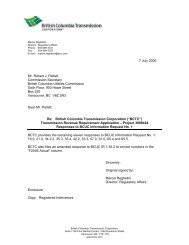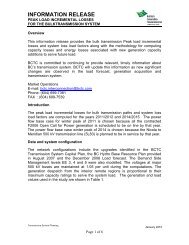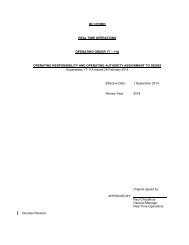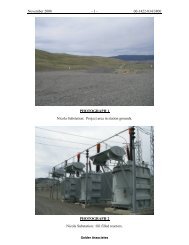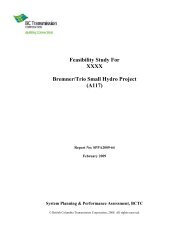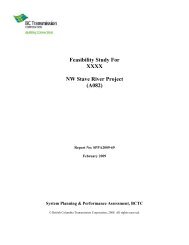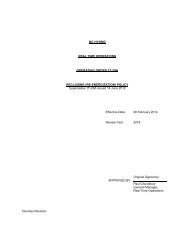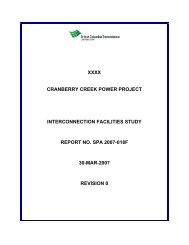Evidence on the Adequacy of First Nations Consultation - BC Hydro ...
Evidence on the Adequacy of First Nations Consultation - BC Hydro ...
Evidence on the Adequacy of First Nations Consultation - BC Hydro ...
Create successful ePaper yourself
Turn your PDF publications into a flip-book with our unique Google optimized e-Paper software.
DRAFT REPORT: Rights and Title Interests in <strong>the</strong> Columbia Valley Transmissi<strong>on</strong> Project Area<br />
According to Schaeffer, traditi<strong>on</strong> suggests that prior to White c<strong>on</strong>tact, <strong>the</strong> Upper Kutenai were<br />
more dependent up<strong>on</strong> <strong>the</strong> rivers for <strong>the</strong>ir food supply—especially during <strong>the</strong> late winter—than<br />
<strong>the</strong>y were during <strong>the</strong> historic period . 226<br />
During <strong>the</strong> period <strong>of</strong> <strong>the</strong> salm<strong>on</strong> runs, fish were taken by means <strong>of</strong> <strong>the</strong> detachable-point spear.<br />
Men would ei<strong>the</strong>r wade into <strong>the</strong> shallow waters <strong>of</strong> <strong>the</strong> spawning beds to spear <strong>the</strong> fish, or spear<br />
<strong>the</strong>m from <strong>the</strong> shore. As well, narrow waterways in <strong>the</strong> Columbia Lakes area were said to have<br />
been blocked <strong>of</strong>f by means <strong>of</strong> nets, and <strong>the</strong> salm<strong>on</strong> thus c<strong>on</strong>fined were speared . 227<br />
The fall catch <strong>of</strong> salm<strong>on</strong> in <strong>the</strong> Columbia Lakes area that was not eaten fresh was sundried <strong>on</strong><br />
drying racks and stored for use five or six m<strong>on</strong>ths hence. For storage, <strong>the</strong>se fish were packed in<br />
“flat envelopes” made from salm<strong>on</strong> skins which were <strong>the</strong>n laid in bark boxes that were stored <strong>on</strong><br />
tree platforms or in log structures. 228<br />
Methods <strong>of</strong> fishing employed by <strong>the</strong> Upper Kutenai <strong>of</strong> <strong>the</strong> Columbia Lakes area included<br />
fish traps used in <strong>the</strong> tributaries <strong>of</strong> creeks and rivers empyting into <strong>the</strong>se lakes. Fish<br />
caught by <strong>the</strong>se methods included whitefish, suckers and squawfish. 229<br />
2.3.3 Hunting<br />
Schaeffer reported that “l<strong>on</strong>g ago” moose were said to be numerous in <strong>the</strong> regi<strong>on</strong> <strong>of</strong> Columbia<br />
Lakes, around Michel Prairie, and fur<strong>the</strong>r north. Moose were sometimes hunted in July, when<br />
Saskato<strong>on</strong> berries ripen, as that was <strong>the</strong> time <strong>the</strong>y were in <strong>the</strong>ir best c<strong>on</strong>diti<strong>on</strong>. A special<br />
cerem<strong>on</strong>y was held when <strong>the</strong> first moose was killed in summer. 230 Sometimes <strong>the</strong> Michel Prairie<br />
people toge<strong>the</strong>r with <strong>the</strong> Tobacco Plains people hunted moose and elk, in winter, north <strong>of</strong> <strong>the</strong><br />
Columbia Lakes, occasi<strong>on</strong>ally as far north as Golden. 231<br />
226 Schaeffer 1934-1969, Reel 1. See also Schaeffer 1940, page 31.<br />
227 Schaeffer 1934-1969, Reel 1.<br />
228 Schaeffer 1934-1969, Reel 1.<br />
229 Schaeffer 1934-1969, Reels 1 and 2. See also Schaeffer 1940, page 32.<br />
230 Schaeffer 1934-1969, Reel 1. See also Schaeffer 1940, page 28.<br />
231 Elsewhere in his notes, citing informati<strong>on</strong> he recorded in 1935, Schaeffer (1934-1969, Reel 2) said he<br />
was told it was “previous to a hundred years ago” that <strong>the</strong> “aganahónek” (Tobacco Plains people) and<br />
“gakawakamitúkinik” (Michel Prairie people) used to go hunting toge<strong>the</strong>r for moose and elk north <strong>of</strong> Columbia<br />
Lakes and “probably as far north as Golden.” These statements were subsequently repeated in a posthumouslypublished<br />
article by Schaeffer (1982, page 6), and in his doctoral dissertati<strong>on</strong> (Schaeffer 1940, page 28). These<br />
Michel Prairie people, like <strong>the</strong> “kátamukinik” people, are said to have been almost entirely wiped out by <strong>the</strong> 1781-<br />
1782 smallpox epidemic (Schaeffer 1982, pp. 4, 8-9).<br />
Bouchard & Kennedy Research C<strong>on</strong>sultants Page 54<br />
Page 57 <strong>of</strong> 200






